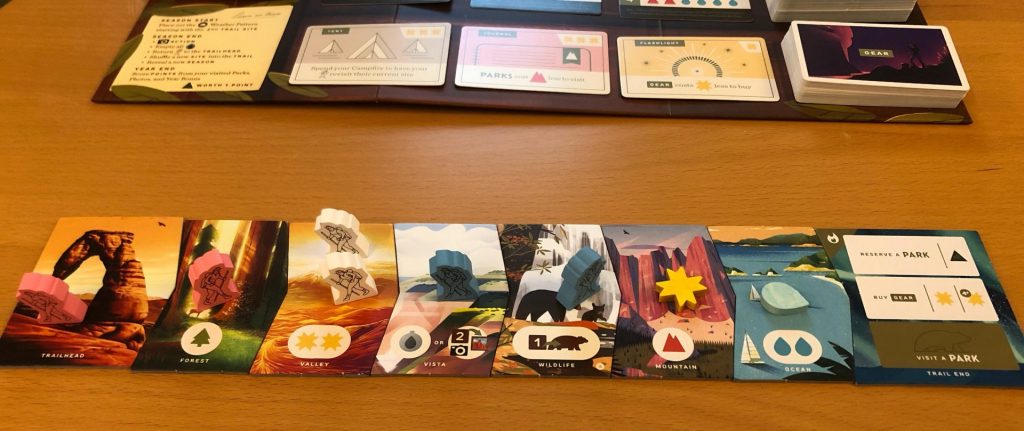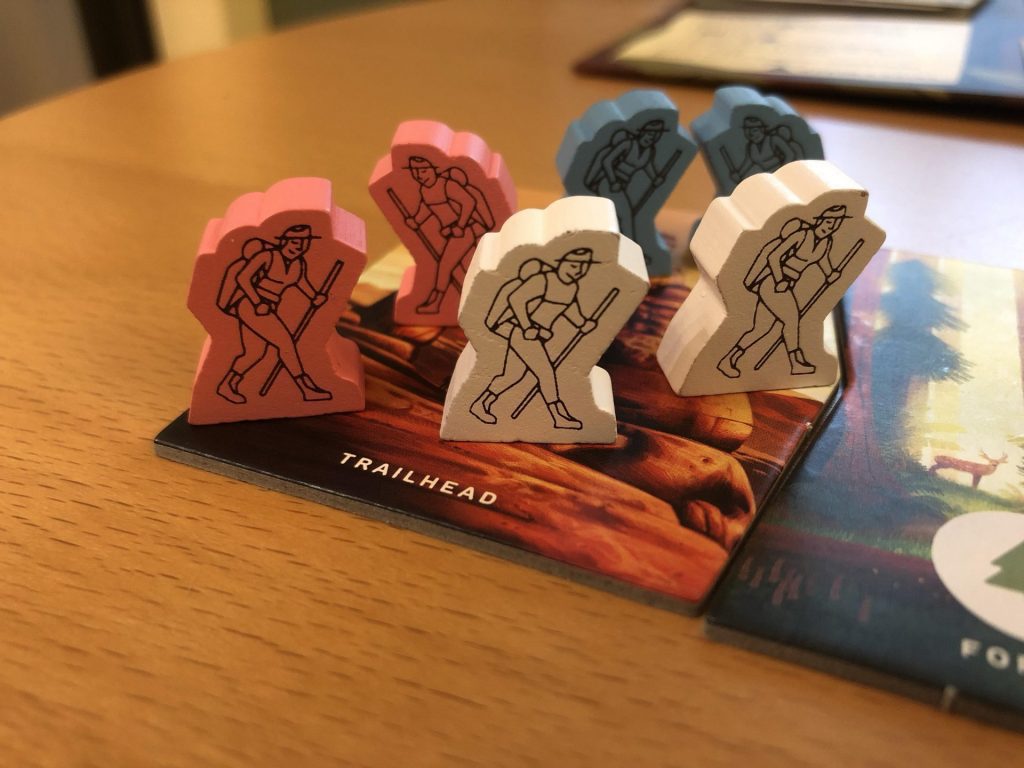One of the greatest things about America is its open country: the purple mountains’ majesty, the amber waves of grain, the fruited plains, and so forth. Nothing exemplifies that more than the National Parks, federally protected lands that span the gamut of terrains, climates, and wildlife. To stand in one of these parks is to be humbled, to truly understand how vast and ancient the Earth is compared to humanity. PARKS, from Keymaster Games, is the latest attempt to capture that indescribable feeling in a board game. Does it succeed? Read on to find out what we think of PARKS!
You can also check out our video review of PARKS.
It’s a Beautiful World
Without a doubt, PARKS is one of the lushest games to come out in a year full of them. Everything about PARKS is beautiful: the cover art, the rulebook, the wooden Hikers, the four types of wooden tokens in various colors, and above all the Parks cards. Keymaster has partnered with the Fifty-Nine Parks Print Series, and the result is nothing less than stunning. Despite having so many artists involved – each of whom receives credit in the rulebook, should you want to look for their other work – the overall effect is cohesively magical.


In addition to the vibrant and inviting illustrations, there’s an incredible amount of attention to detail throughout the production. Every single piece has a proper place in the custom designed Game Trayz inserts and on the board, which makes set-up and tear-down a breeze and ensures that pieces don’t get mixed up in transport. The various Trail tiles that make up the modular movement board are wonderful, fitting together perfectly, and even the token holders have been shaped so that they slide into place in the box. Just opening the lid and seeing how much care has gone into this game makes you immediately want to jump in and play it.


Golden Years
A game of PARKS takes place over 4 rounds, called Seasons, which collectively represent a single spectacular year of exploring the boundless beauty of America’s National Parks. The ultimate goal is to have the most points at the end of those 4 rounds, and there is a bevy of ways to get points: visiting National Parks, taking Photos (which can only be done at specific locations and times) and meeting the personal goals on a hidden Year card. There’s also a single bonus point for the player holding the first turn marker at the end of the game.
During each round, players will take turns moving one of their two Hikers along the Trail, a series of terrain features that offer different resource tokens or actions to take. The Trail is shuffled from round to round but always consists of the 5 Basic tiles and a number of Advanced tiles equal to the current round number. On their turn, a player can move one of their Hikers as many spaces forward as they choose; however, they cannot land on the same space as another Hiker (even their own) without using their Campfire, which only re-lights when one of their Hikers hits Trail’s End.

Once a Hiker reaches the end of the Trail, the player can choose one of three options: Visit (purchase) one of the 3 available Parks by spending the appropriate set of resources; use Sunshine to buy one of the Gear cards, which typically open up different actions or reduce costs elsewhere; or reserve a Park for later purchase.

To Every Thing There Is a Season
Each randomly-chosen Season card has two important elements: a weather pattern, which will add additional resources for collection on most of the Trail’s spaces; and a global rule that will tweak some aspect of gameplay, though usually not by much. Visiting a Forest, for example, always nets the player a single Forest token, but perhaps a bout of clear weather lets the first player to land on that Forest collect a Sunshine token as well. The same card might also reduce the cost of Visiting a Park by 1 Sunshine, so Season cards can be very influential in shaping a turn.

The basic structure of resource management games – get tokens, convert tokens of one type to another, use appropriate sets of tokens to acquire things – is fundamentally unchanged from other iterations you might have seen. In many ways, PARKS feels akin to something like Lords of Waterdeep, which is not a bad thing. The core gameplay feels extremely well-balanced overall, with no particular strategy immediately dominating. Games routinely end in close totals around the 20-35 points range, so whoever can eke out a few extra points by taking more Photos or completing the difficult goals on their hidden Year card is likely to win the game.

I Like the Way You Move
What sets PARKS apart, besides the luxurious components, is the tension of its strategic movement aspect. There’s a phenomenal balancing act at play here that makes every lifted Hiker feel much weightier than it should. You can be a sprinter, charging forward to steal away the best Park or Gear before those slowpokes behind you, even if that means you’re constantly struggling to amass resources. Or you can be a stroller, sauntering along and picking up tons of tokens to ensure that you can afford whatever’s left over at Trail’s End. Better, because you have two Hikers, you can split the difference, moving one in huge leaps to cherry-pick the best spots while the other dawdles in the back to snap photos and snap up resources.

The limited use of the Campfire is paramount, too. You’ll never get to stop on a single space more than twice in a round, and clever players will “camp out” on a valuable spot to prevent other players from accessing it at all. Having the option to “burn” your Campfire to get that make-or-break token can salvage an otherwise disastrous round, but then what happens if there’s a similar roadblock down the line? Can you afford to rush a Hiker to Trail’s End to get that ability back? Can you afford not to?
The possibilities for movement are seemingly endless. Players who enjoy optimizing their performance will find a surprising amount of depth to movement and blocking, while those who are prone to analysis paralysis may occasionally struggle to make their move at all.
Pushing Through the Overgrowth
And that’s ultimately PARKS’ greatest strength, as well as its greatest flaw: there’s an awful lot to think about for such a small game. Moving in a way that gets the resources you need is complicated enough, but adding the always-on Gear cards, the round-specific Season rules, the once-or-maybe-twice-per-round Campfire ability, the once-per-round-but-only-if-you-picked-up-a-water-token-this-turn Canteen abilities…What seems at first like a straightforward path can sometimes turn into a rocky uphill climb.

Casual gamers in particular may find themselves constantly unwinding previous turns to figure out whether they overpaid for something or to take advantage of an option they forgot they had. That’s a shame, because the game is so beautiful that everyone who sees it will want to play it, and an ever-so-slightly less fiddly ruleset would make the game more accessible without sacrificing any of the strategy.
Who Needs the Buddy System?
Ironically the strength of the game’s strategic movement means that it works pretty well even as a solo game. Playing solo is basically the same as the multiplayer game, replacing the opponents with a set of Park Rangers that act according to a pretty limited script, with occasional wrinkles in the form of Event cards that can disrupt the unprepared player.

That may not sound as interesting as the multiplayer format, yet it’s actually quite engaging. The ease with which the Rangers’ turns resolve, coupled with the fact that they don’t linger to maximize their own benefits, keeps the game moving at a brisk pace. The focus is squarely on accomplishing the most you can in the short time you have, and while there isn’t as much emphasis on blocking, there are some clever ways to manipulate the Rangers’ turns through strategic placement of your own pieces. It’s a slightly more puzzle-y take on the game. PARKS’ solo mode isn’t quite difficult enough to justify buying the game for it, but it’s a very enjoyable option for a rainy day.
Trailing Off
PARKS is a must-see game. No picture or video can do justice to how amazing it looks on the shelf and on the table. And despite a few caveats, it’s a lot of fun to play as well, with subtle strategic depths ripe for exploration. This is a fantastic mid-weight game that will strain your brain almost as much as it thrills your eyes, and there’s every reason to believe that 2019 might be remembered as the Year of PARKS.
Make sure you also check out our video review of PARKS.
For more PARKS fun, watch our video review of PARKS: Nightfall, the game’s first expansion.













Concise review of the game Ian Howard. One of the prettiest looking games I’ve ever played. It the kind of board game that even seasoned gamers take pictures of and post online. Like most modern games, Parks requires a flexible strategy to take some control over the randomness of the cards and board that changes with every season. The 4 – 5 player game is excellent for both the non-serious and hardcore strategist. The solo game is solid and you’re right, the ranger movement keeps things challenging. However, I found Parks to be lacking as a 2 player game because the board was just too open. There’s not much advantage to racing ahead because of the number of good spots available. My wife and I played a few games together and were scoring between 35 – 55 points each with maybe only one outlier. Anyway, excellent review, keep up the good work.. .